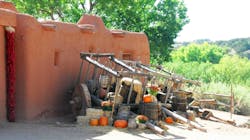Don’t you just love it when several of your favorite things come together at the same time? That happens every fall for me because first of all, I love the fall season with its fabulous foliage and cool weather. In New Mexio it also marks the start of fall fiesta (festivals) season, which are usually associated with history in one form or another. That makes it a trifecta of favorite things since I love both of these activities too.
What got me focused on these topics were recent announcements for the annual fall harvest festival being held at “El Rancho de las Golondrinas” (the ranch of the swallows). Las Golondrinas is a living museum that dates back to the early 1700s and houses many historical buildings in a bucolic setting. Its volunteers and docents take visitors back to a less complicated period where 18th century technology abounds.
I don’t know why, but there’s something about older technology that’s reassuring, maybe it’s nostalgia for a less complicated world. Watching a waterwheel-powered gristmill grind grain is soothing, but it was probably unsettling to those whose job was crushing grain between handheld rocks. There’s no getting around it, the world has gotten a lot more uncomfortably complicated.
Keeping Up with the Times
This came into focus last year when I wrote about problems with my home’s air conditioner and was looking at replacing it. The new technologies were very different, and they led me into something unexpected. As I researched the latest technologies it became apparent that industry standards were not keeping up with global warming and the environmental changes it was causing. Unfortunately, it was not just refrigeration standards needing updating.
With that in mind, it was perfect subject-matter for the October 2022 “Charging Ahead” editorial titled “Changing Standards For Climate Change.” After the column’s publication, I continued watching the efforts of numerous groups working on updating the guidelines, practices, and standards used by our industry. Interestingly, the results have been both encouraging and discouraging.
On the encouraging side of the equation I ran into an article titled “Is My Substation Ready For The Next Extreme Event?” It gives an interesting summation of ASCE’s work to revise those guidelines, procedures, and standards used in building the power grid with an eye towards our changing environment. This article can be found in this year’s “ASCE Lines and Structures” special supplement included with the October 2023 issue of T&D World.
Regulatory Support
There was the discouraging side of the equation to consider too. There has been some strong pushback due to the cost of these upgrades. There is also the idea that there isn’t a problem because these old-school standards are based on solid engineering and so on. Luckily DOE (Department of Energy) is weighing in on the side of updating. Last year they announced their “Building A Better Grid” initiative. It calls attention to an aging grid and making it more resilient to the impacts of climate change.
Likewise, early this year FERC (Federal Energy Regulatory Commission) published a number of positive measures addressing the reliability and resiliency risks created by climate change. One asks transmission providers to make reports on if they have made extreme weather vulnerabilities assessments to their systems and how they did it. FERC also finalized a rule requiring NERC (North American Electric Reliability Corporation) to update the national reliability standards to require planning for an extensive array of extreme weather risks, including extreme heat and cold.
One report I read said this order requires utilities and transmission operators to perform detailed evaluations of the risks from extreme weather events. It doesn’t stop there. These grid operators are expected to take corrective action where risks are identified. This brings us back to the need for updating guidelines, procedures, and standards we use to redesign and remodel the power delivery system.
To aid in this task, the Pacific Northwest National Laboratory (PNNL) published the report “Emerging Best Practices for Electric Utility Planning with Climate Variability: A Resource for Utilities and Regulators” last May. PNNL said the report is intended to help utilities and regulators work together as they address climate issues and the power grid.
In last year’s editorial I said I thought “adapting our grid’s standards to climate change is going to be a trending topic.” This year I’d like to add it’s going to be a rocky process. This new reality requires new standards because inaction has consequences – failure!
About the Author
Gene Wolf
Technical Editor
Gene Wolf has been designing and building substations and other high technology facilities for over 32 years. He received his BSEE from Wichita State University. He received his MSEE from New Mexico State University. He is a registered professional engineer in the states of California and New Mexico. He started his career as a substation engineer for Kansas Gas and Electric, retired as the Principal Engineer of Stations for Public Service Company of New Mexico recently, and founded Lone Wolf Engineering, LLC an engineering consulting company.
Gene is widely recognized as a technical leader in the electric power industry. Gene is a fellow of the IEEE. He is the former Chairman of the IEEE PES T&D Committee. He has held the position of the Chairman of the HVDC & FACTS Subcommittee and membership in many T&D working groups. Gene is also active in renewable energy. He sponsored the formation of the “Integration of Renewable Energy into the Transmission & Distribution Grids” subcommittee and the “Intelligent Grid Transmission and Distribution” subcommittee within the Transmission and Distribution committee.
